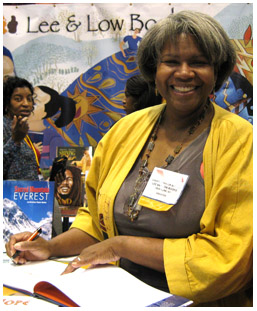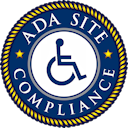![]() We’ve been asking our authors and illustrators for their tips for book signings – Part 1 included advice from Lulu Delacre, Joseph Bruchac, and Lee Bennett Hopkins. Part 2 featured tips from Tony Medina, W. Nikola-Lisa, and Anastasia Suen. More helpful advice below from those with considerable experience on the road for those who are just getting started.
We’ve been asking our authors and illustrators for their tips for book signings – Part 1 included advice from Lulu Delacre, Joseph Bruchac, and Lee Bennett Hopkins. Part 2 featured tips from Tony Medina, W. Nikola-Lisa, and Anastasia Suen. More helpful advice below from those with considerable experience on the road for those who are just getting started.

Christine Taylor-Butler at ALA
Authors and illustrators are required to wear many hats if they want to be successful in the book business. Not only must they be the driving force behind the creation of their book, they also have to act as the book’s biggest cheerleader. Some may not be comfortable donning the marketing/publicity hat, but skills in this area can be developed over time. One question you should ask yourself is: Who else knows my book better than me? After all, your book is a project that has taken you months, even years sometimes, so isn’t it worth the effort to sing its praises from the highest rooftops?
What follows is a collection of tips from some of our authors and illustrators on how to make an impression when talking about your book during a signing, spreading enthusiasm, and selling books.
Open Invitation: If you are an author or illustrator and would like to contribute your own tips, please leave a comment below. Everyone benefits from passing the hat and sharing.
Christine Taylor-Butler (author, Sacred Mountain: Everest) I find marketing to be harder than writing the actual book. Somehow the fear of rejection seems much more acute after publishing a book than before it. But I don’t want my books to get lost among the thousands of others being released that year. So here’s one tip that will help you build name recognition:
Attend professional conferences where booksellers, teachers, and/or librarians gather. (ALA, BEA, and others). Students may be your target readers, but these professionals make many of the purchase decisions and build the buzz for books they like. Call your publisher and offer to sign books at their booth. They may not have the budget to pay your travel, but they might buy your exhibit pass. Even if they don’t, the cost to visit the exhibit floor is often as low as $25. Buy your own pass and go. Then email, Twitter, or Facebook as many friends, peers, teachers, and librarians as you can. Let them know when your book releases or if you’ll be featured at a book signing.
Now begins the hardest task: reaching out. With so many booths competing for their attention, many attendees at a conference won’t stop without a reason. Give them one. Make eye contact and ask if they’d like to know more about your book. At the Lee & Low booth I set up a laptop with video clips of Apa Sherpa climbing Mount Everest. He holds the world’s record for climbs to the summit (20). When someone looked at the video I pointed to the book, let them know that Apa provided many of the photographs, and asked if they’d like to know more.
It wasn’t in my comfort zone, but I was able to speak passionately about my favorite parts of the book: the superhuman strength of the Sherpa, who claim the Himalayas as home; the superhuman strength that allows them to climb to the summit of Everest in eight hours (versus six to eight weeks for us mere mortals.) Lee & Low sold out of the book that afternoon. Another signing was scheduled for the next day and we had to take orders. But that’s a great problem to have and the buzz on the book began that day in earnest.
Be your own best advocate. If you aren’t passionate about your book, why expect anyone else to be? So get out of your comfort zone and make a few lasting friendships along the way. Next time, maybe the person won’t need you to pull them over. Maybe next time they’ll be looking for you!
Jesse Joshua Watson (illustrator, I and I Bob Marley, Chess Rumble): I have a saying that may or may not be appropriate, but better to apologize than ask permission, right? The phrase I rely on during signings or exhibits is: Pimp Hat On. It is the perfect way to explain the transition that must happen for a typically cave-dwelling, introspective author/illustrator in order for public events to be successful. Your goal is to sell books and sell yourself.
If you think of this duty you have to your book, to help it get out there and meet the world, you will see that there is a need to be the guy or gal who “gets the job done.” Which is so very often NOT the guy or gal sitting behind the keyboard or easel. However, if you consciously put on your Pimp Hat and adopt the characteristics needed to shamelessly spread the word about your book, you will see results! It is not a crass, annoying persona you are putting on, after all. It is a broadcaster. A big smile and a ready conversation. Polish the elevator speech/summary, so that you can fire it off at the drop of a hat. Know your work well enough to give genuine and meaningful answers to questions. And, author/illustrator . . . feel no shame about wearing the Pimp Hat when you must. It does not reflect negatively on your artistic soul. It just means you might be able to eat this month. Done and done.
Paula Yoo (author, Shining Star, Sixteen Years in Sixteen Seconds) When I go to book signings, I always make sure to ask questions about the reader’s life as well to get to know her or him better. I ask where the person is from, what he or she does, and what other books/authors the person likes. If someone is a teacher or librarian, I ask specific questions about the jobs and if her or his school hosts author visits. I always try to get a business card or contact info, and I always give out my business card for possible school presentations. After the book signing, I always do follow-up emails to the librarians, bookstore owners, and teachers that I’ve met to keep in touch with them for future visits (hopefully) and to keep them updated on my next books.
When I meet fans who are book lovers and/or students, I always encourage them to visit my website so they can keep up with my news and blog postings. I encourage them to sign up to be a member on my website so I can include them in any emails I send out about my latest books. I also recommend that authors request— if possible— business cards and/or postcards and bookmarks from their publisher. If these items are not available from the publisher, it’s very easy to make some of your own using such places as next day flyers or even your local Kinko’s. Readers who approach you at signings love these free “souvenirs.” In addition, if you sell out of books, you can always sign the postcards and bookmarks to keep your readers happy!
Of course, you have to do this all within a reasonable amount of time to keep the line moving and not “hog” anyone’s time. It’s a tricky balancing act, but you get better at it with every book signing. So I would recommend being as friendly and personable as you can with people who attend your book signings. It’s an honor to meet my readers, so I try to make their book signing experience as memorable as possible.
Make sure to check out: How to Plan a Successful Book Signing Part 1 and Part 2









